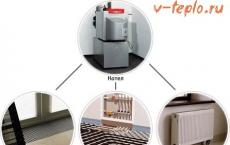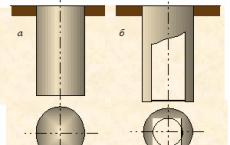Reliable thermostats for radiators. Thermoregulators for radiators.
In the cold period, I want to create comfortable conditions in the room. Heating devices, giving out heat, are unable during the day to change temperature regime.
Too much heat is generated in conditions of total saving to pay absolutely not cost-effective. To create a normal heat transfer, a thermostat is installed in the heating system in front of the radiator. The temperature control device has compact shapes that can merge with any design of the room.
The range of the supported mode is from 6 to 26 degrees.
The principle of operation consists in the operation of the shut-off valve, its ability to adjust to the radiator. The thermal head, sensing the room temperature, acts on the valve, according to the set mode.
The valve, in turn, covers the flow of heat into the radiator. The device, reacting to the preset mode, does not allow unnecessarily to warm up the air in the room, thereby saving the coolant flow. The quantitative method of regulation affects the use of the coolant, which for the entire period heating season can save 10-30% of costs.
The design of the device is:
- valve;
- thermal head;
- fixing mechanism;
Advantages and disadvantages
Pros:
- Easy installation necessary regime.
- Long service life.
- Does not need maintenance.
- Relatively low price.
- Evenly distribute heat in system.
- Saving costs.
- Laconic design.
- Fast payback.
Disadvantages are difficult to determine, since a simple device with proper installation fully functions and does not require special attention:
- Inaccuracy of the set temperature in mechanical models.
- Price automatic thermostats.
Kinds

Electronic thermostat
Currently, manufacturers produce the following types of thermostats:
- Mechanical.
- Electronic.
- Electromechanical.
The working body of a thermal head can consist of:
- From paraffin.
- Liquefied gas.
- Alcohol or oil.
Each temperature controller is equipped with a temperature sensor.
It can be built-in, programmable, remote:
- Mechanical thermostat: The adjustment is done manually with a valve.
- Device with remote sensor: The thermal head is installed in places protected from heat and sun. The heat flow from the radiator or from the sun's rays distorts the sensor's temperature control. Therefore, remote installation raises the effectiveness of the device.
- Thermostat for circulating pump: installation is required on each radiator. Influences the operation of a, resulting in a decrease or increase in heat productivity.
- Electronic thermostat: It is equipped with software control with the possibility of setting an individual mode.
- Automatic device: The principle of operation resembles a separate heating management system. Does not need constant attention, responds to climate control on its own. The valve is controlled by an electromagnetic relay.
- Devices for: regulate the heat transfer of the radiator.
- Device for apartment buildings: design for a single-pipe system. The installation should include the installation of a bypass pipe. Without it, the thermostat can significantly reduce the heat dissipation of other radiators.
The issue of choosing a device for climate control is often discussed by installers and consumers. Each body of the thermal head has its advantage: the gas reacts faster to a room temperature drop, the liquid has a more precise effect on the moving mechanism.
The automatic thermostat has the most positive reviews. The work of the device is evaluated as the most effective. In any case, it is necessary to purchase a device of good quality, guaranteed by the manufacturer's reputation.
The best manufacturers
Danfoss
![]()
The company, founded in the 30s of the last century in Norrborg. Specialized in the production of industrial and refrigeration equipment, thermal automation.
Prodigy
The Italian concern. In the market of household and thermal automation for more than 30 years.
Salus Controls

The company is owned by the world-famous company Computime Group Limited. Innovative solutions when creating products guarantee customers savings. This is the strategy of the enterprise.
AURATON
Polish manufacturer, one of the leaders in the production of heating system products.
HERZ
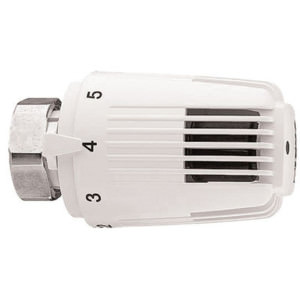
A large enterprise founded in the late 19th century in Austria. At the end of the 20th century, the production set a course for the production of fittings for heating appliances.
Euroster
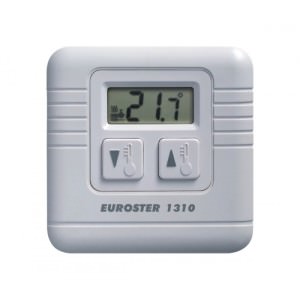
The leading Polish company for the production of heat regulators.
Where and how to install?
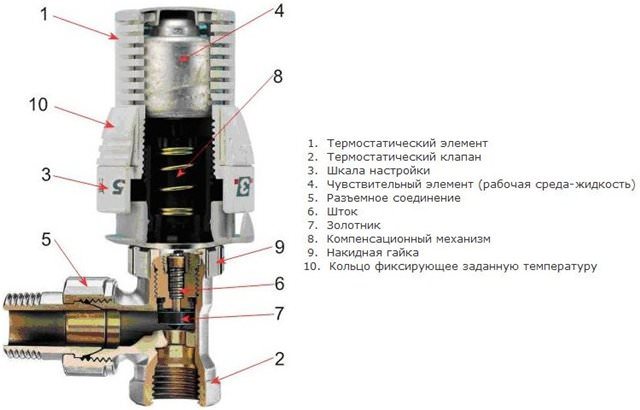
Thermostat device
The thermostat is installed directly at the entrance to the radiator or on a horizontal pipe in front of it. However, one must take into account that for effective work regulator conditions are necessary. Curtains, pieces of furniture, decorative grilles should not restrict the space of the device, and the sun's rays do not act directly.
The thermal head under the influence of additional heating can not accurately determine and regulate the temperature. These rules do not apply to models with a remote sensor, which can be located 8 mm from the valve.
Before installing the device, it is necessary to close the water in heating system and merge it. It is possible to perform the installation in-house, observing technology and order.
To do this, you need the following tools:
- bulgarian (trimming pipes);
- chisel (thread cutting);
- insulating tape (joint sealant);
- welding (for changing the heating circuit);
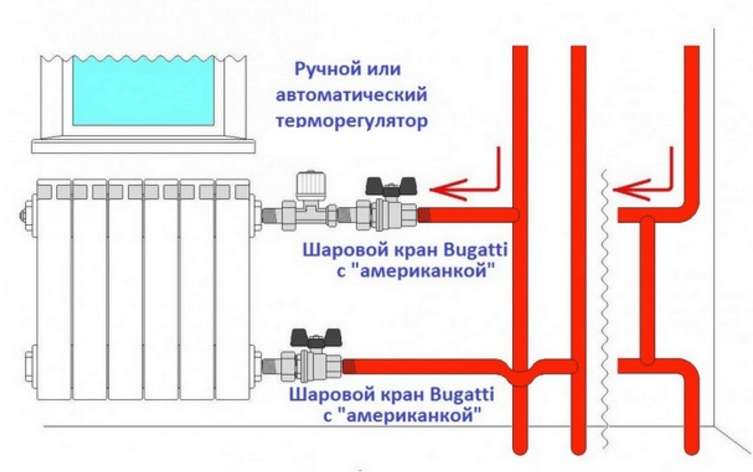
Installation diagram
Walkthrough:
- Cut off horizontal tubes from the battery and disconnect them.
- If there was a tap at the entrance to the radiator, it needs to be dismantled.
- From the valves, detach the shanks and tighten them with the nuts in the battery plugs.
- Collect and install a tubing in a certain location.
- Connect the harnessy to the heating system.
When installing the thermostat to single-pipe system, a jumper must be installed between the back and the straight line. In a two-pipe heating design, the regulator is connected to the top connection of the radiator.
The instrument must be adjusted according to instructions or with the help of specialists.
Setup stages
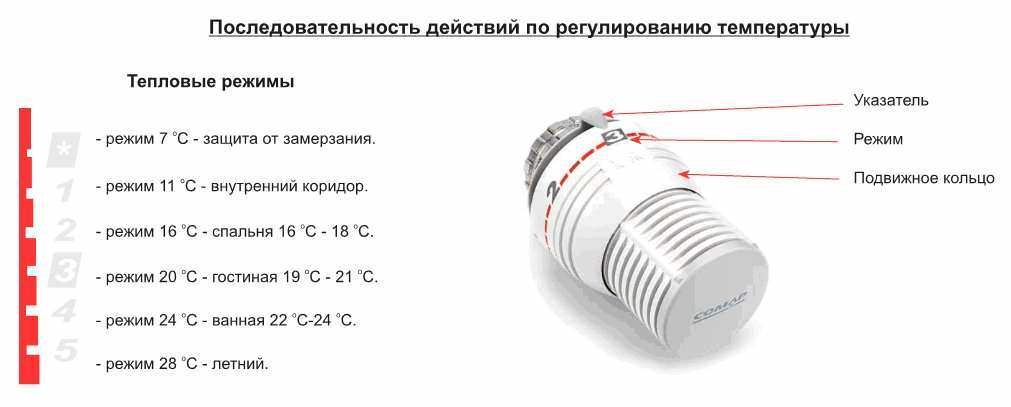
- Create the atmosphere in the room, closing the windows, windows and doors.
- In a place of constant temperature control install a thermometer.
- Turn thermostat head all the way to the left for maximum heating of the radiator.
- After increasing the room temperature by 5 degrees, you need to close the valve by turning the knob all the way to the right.
- When the temperature value drops to the desired value, gently turn the regulator head to the left until the characteristic sound of water in the instrument. The position of the device handle will display the selected heat transfer mode.
Price and reviews
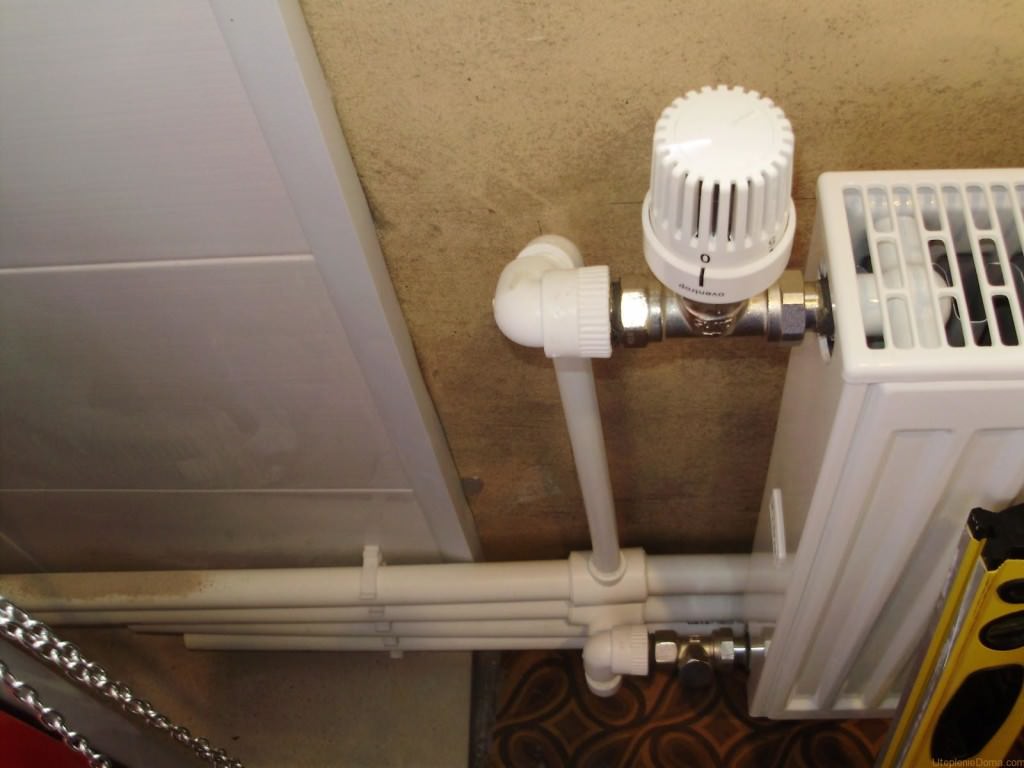
Different types of temperature controllers and the scope of the price segment allow each buyer to choose a model by pocket. The methods of control, the presence of sensors, types of construction make a significant run-in to the cost.
Autonomous systems most accurately determine and maintain the temperature regime thanks to built-in electronics. Hence the relatively high price. But it is worth remembering that by purchasing a quality device, each customer is guaranteed to receive savings for heating.
Rates:
- Mechanical models are offered in the range of 675 r. - 2760 r.
- Automatic regulators 2350 р. - 4100 r.
Danfoss models:
- RA 5065 from remote control - 5080 r.
- RA 2922 - 3200 r.
Euroster models:
- 80 RX - 2300 r.
- 2510 TXRX - 703 r.
- ROSSWEINER PH60 - 396 r.
- Oventrop Uni FH M30X1.5 - 615 rubles.
To ensure the most rational use of energy and the subsequent reduction in the cost of paying bills, heating systems, among other things, are equipped with special controls known as temperature controllers. The devices under consideration have a fairly simple design and are installed and connected without any problems with their own hands.
The design of a standard thermostat for a radiator consists of valve and special thermostatic head. In the device under consideration, the valve is so called. executive device. The composition of the thermostatic head includes a special cylinder with a working substance. This substance is sensitive to temperature changes and it is thanks to it that the thermostat can perform its main function.


With increasing temperature, the volume of the substance under consideration increases. A decrease in temperature leads to a reverse reaction. With such changes in the volume of matter, the push rod, coupled with the cylinder, moves.
The thermostat head is mounted on the valve. With constant expansion and compression of the material, the rod squeezes or releases a special locking spring-loaded cone that opens or closes the passageway, controlling the supply of the main coolant.
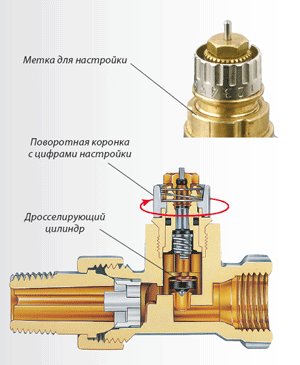

The thermostat for the radiator can work with the use of gas and liquid working substance. In accordance with this parameter, existing instruments are divided into gas-filled and liquid. Thermoregulators with a gas working substance respond more quickly to temperature changes. The liquid reacts more precisely to the pressure drops in the cylinder, which allows for the most precise temperature control.
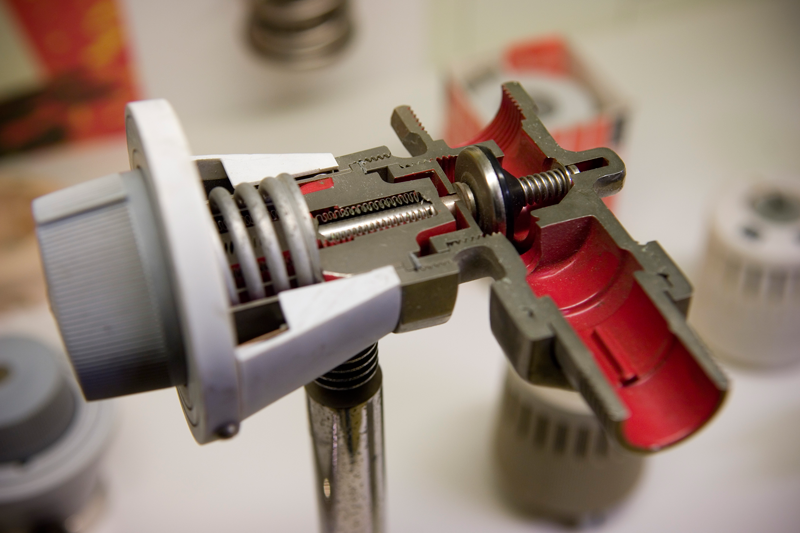

The thermostat operates on the same principle, as in simple single-tube, and in two-pipe heating systems. The difference is only in the magnitude of the resistance of the valves: in single-pipe heating systems, this parameter is noticeably lower than for two-pipe heating.
A suitable thermoregulator should be selected at the design and development stage of engineering systems. In the case, if the device will be installed on already installed and connected heating batteries, the efficiency of its operation will significantly decrease.
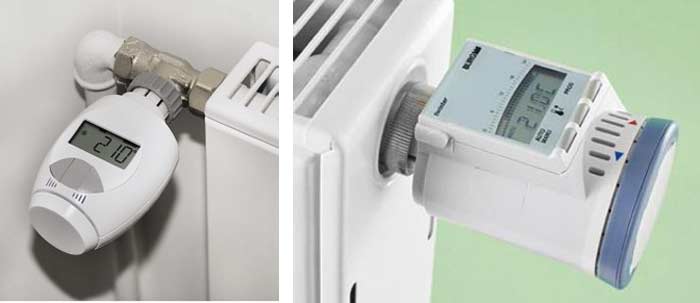

Thermostats with manual and automatic program control are available for sale. Software models are more convenient. Their device is such that they allow you to control the temperature in the heated room, adjusting to a variety of additional factors, for example, the time of day. Electromechanical devices can only maintain the temperature at one set level.
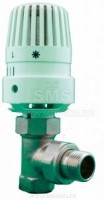

The mechanical thermostat operates according to the iron principle: when the room is warmed up to the set temperature, the device switches off, and as soon as the air cools down a couple of degrees - it turns on again.
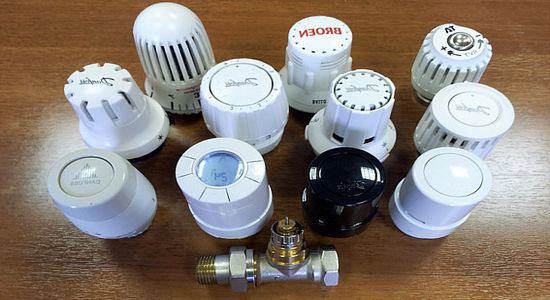

Thermostats are a large group of instruments designed to maintain the temperature at a certain constant level. There are several types of thermostats classified according to the principle of action, namely:
- passive. Such devices operate in isolated conditions. To protect from the environment, special materials are used;
- active. Automatically maintain the temperature at a given level;
- phase transition. The principle of operation of such devices is based on the property of the working substance to change its physical state, for example, from liquid to gaseous.
In everyday life, the most popular active thermostats. It is these that are commonly called thermoregulators and. Most of the existing instruments intended for temperature control are equipped with a suitable thermoregulator even at the stage of their factory assembly. It is only necessary to carefully read the instructions to the device before using it.
There are also remote thermoregulators. They are made in the form of a separate block. Connection to the radiator is carried out in accordance with a certain technology, without observing the requirements of which one can not count on the efficient, economical, safe and long-lasting operation of the installation.
Modern thermostats have many advantages. One of them is the extreme ease of use. Such devices are easy to install and continue to use, it is quite easy to understand. Instruments of a modern design help create the most favorable and comfortable conditions in the premises. They allow to save considerably on heating and to spend resources as much as possible rationally.


In addition to maintaining the necessary temperature and creating comfortable microclimate A very important point is the saving of thermal energy. So, for example, in apartments that are heated by means of centralized heating, for additional savings, it is necessary to install thermostats and a heat meter, and in the case with individual heating all savings are reduced to a decrease in the amount of energy consumed, which is achieved with the help of temperature controllers.
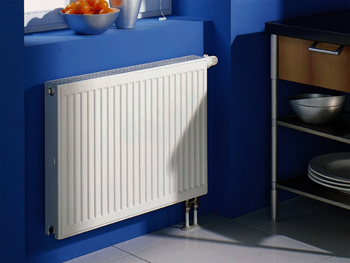

If the heating is only at the planning and development stage, it is best to buy radiators with already built-in thermostats and. However, the installation of the thermostat will not cause any difficulties in the case of already ready systems. It is only necessary to tune in to work and prepare the necessary tools for this.
Thermostat connection set
- Bulgarian, hacksaw or electric jigsaw.
- Set of wrenches.
- Pipe clumps.
- Plumbing paste.
Prepare everything you need in advance so that you do not get distracted in the future to find missing items.
Step-by-Step Guide to Installing the Temperature Controller
Thermostat installation technology extremely simple in its execution. The device is connected in only 4 basic steps. Follow each one in turn.
The first step is the preparation of a radiator for the installation of a thermostat. Disconnect the battery and drain the water. Remove the valve if it is available. The single-pipe heating system must be equipped with a bypass. This simplest jumper in its design will allow the heat carrier to circulate in the system even in the event of a separate radiator shutdown. That is, you will not cause inconvenience to neighbors and do not disrupt heating in other premises of your home.
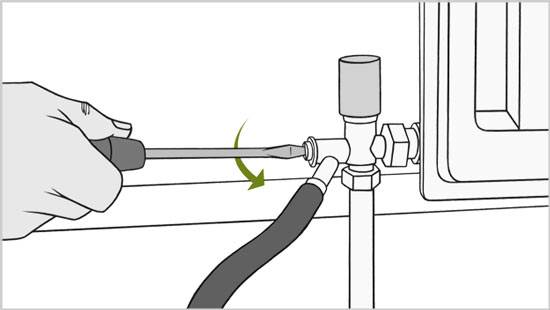

The second step is the installation of a thermostat. When installing the device in question, a threaded connection is used. The thread is necessarily sealed with plumbing, pre-impregnated with some paint. Screw the regulator into the battery inlet for the coolant inlet. Do this without much effort, otherwise you risk damaging the body of the product. The valve is marked in the form of an arrow. It is important that its direction is the same as the direction of motion of the coolant.
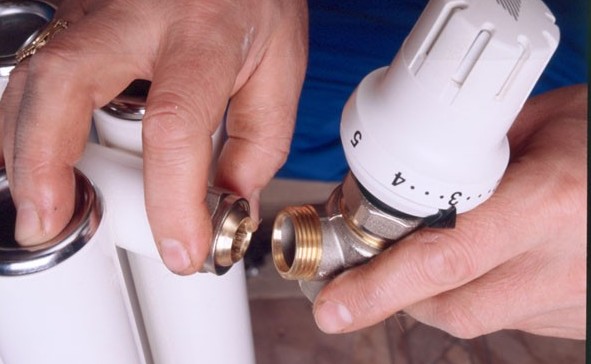

The third step is the installation of a thermostatic element. This device is designed to determine the temperature in the room. It is also responsible for controlling the locking mechanism. It is installed in a horizontal position. The element composition includes a temperature sensor. It is important to install in such a way that the heat of the radiator does not directly affect this sensor.
If for some reason you can not install the device horizontally, it is strongly recommended not to leave everything as is, but to buy a model with a convenient remote sensor. It can be installed at a distance of 2 m from the battery and even more.
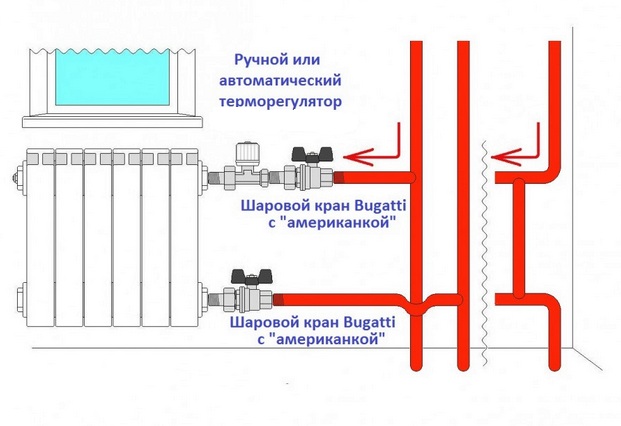

Installation of the temperature sensor must be performed in accordance with certain rules, namely:
- the device should be located at a height of at least 80 cm from the floor surface. Cold air in accordance with the laws of physics is going down. Contact of the temperature sensor with such air will reduce the accuracy and efficiency of the system;
- the temperature sensor must not be exposed to direct warm air. Consider that it can come not only from the radiator, but from a variety of household appliances;
- the device should not be exposed to direct sunlight;
- the sensor must not be covered with furniture, storms and other similar objects.
Staples are used to attach the remote temperature sensor. Pick up appropriate place for installation and install the device in question.
The fourth step is the adjustment of the thermostat and the preparation for use. When the heating system is switched on for the first time, the thermostat should be calibrated and adjusted. Adjust according to the instructions that go directly to your device, because for different models the procedure for doing this procedure may be different. The general rule is only one - to proceed with the adjustment can only after full and uniform warming up all available in the home of heating appliances.
Thus, in self-installation Thermostat for radiator heating is nothing complicated. After understanding this work and gradually performing all the required operations, you can conveniently adjust the level of space heating, ensuring the most rational use of energy, which will significantly reduce the total cost of heating.
Thermoregulators for heating
Successful work!
Sometimes there is such a desire or even necessity, to adjust the temperature in each separate room. To do this of course you can by installing a special device on the radiator - a thermostat or as it is also called a thermostat. This is a very small device capable of regulating the heat transfer of a radiator intended for heating. Suitable for all batteries, except for cast iron. The temperature regulator can only lower it, but not vice versa.
Thermostat for heating batteries: device
The radiator adjustable sensor consists of two main parts - a valve and a thermal head. Manufacture of such products for different pipe diameters and types of system heating. The thermostatic element is removable, therefore different types of regulators can be installed on the thermo-valve. The landing site is standardized.
The thermostat can work when using a working substance, gas or liquid state. Therefore, they are divided into liquid and gas-filled. Both types are considered high-quality products, but liquid ones are more in demand, therefore their assortment is much more diverse.
Thermocran is a conventional valve consisting of a metal casing, where there is an opening, as well as a cone and a saddle. The locking mechanism in this system is a cone, which, in turn, rises and falls under the influence of the coolant.

The internal structure of this product:
- Thermostatic head;
- Valve;
- Thermo balloon;
- Stock;
- Spindle;
- Bux.
The thermal head is a regulator of the device, with it the battery has a certain temperature regime, it is a replacement part. Valves are divided into two types: for single-pipe systems or for two-pipe systems. For each system, you must choose the right model.
Thermostat for heating and its variants
The thermostat is a device that can maintain a certain temperature at a constant level. To produce such a device, very strong and reliable materials are used: bronze, stainless steel and brass.
Stainless steel is the most excellent option for such a device. They are not corroded, durable and chemically neutral. However, stainless steel products are pretty decent. Brass and bronze devices are cheaper, but they are also of high quality.
Suitable, it is for your heating system, the temperature sensor needs to be purchased in advance. If the device is connected to an already installed radiator, then its efficiency may decrease.
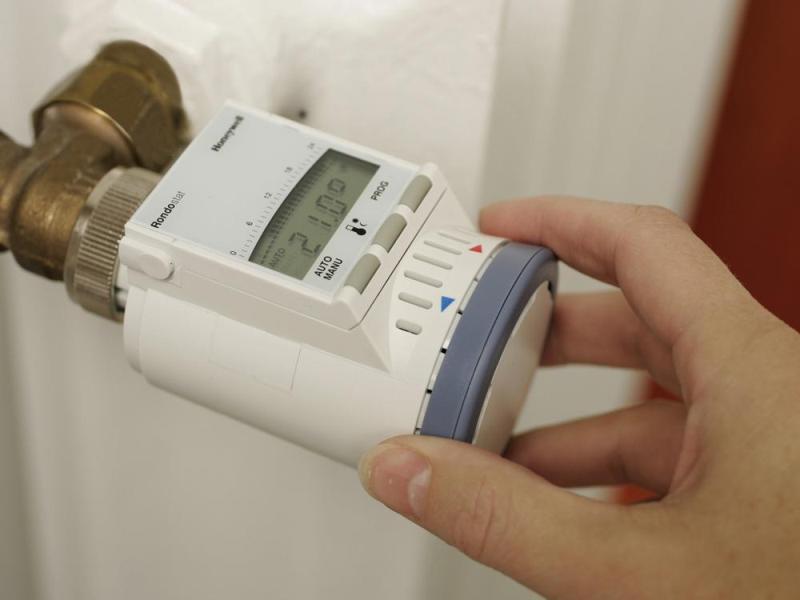
Kinds of thermoregulators:
- Manual;
- Auto;
- Mechanical.
The automatic temperature regulator is the most convenient of the instruments, therefore it is the most popular. To use such a sensor is very easy, just put it in the right place. You can put it on the device itself or at the entrance to the radiator. The handheld device is controlled only with someone's help. You can meet and another kind - it's an electrical controller that runs on batteries. Such a device is large and many additional functions. For example, he is able to set the temperature by the clock in the right room for you. This is a very convenient, but expensive device.
Thermostat on the radiator: advantages
Otherwise, such a device can be called a radiator thermostat. Of itself, it represents a special unusual mechanism that joins the input of the radiator and regulates the temperature entering the battery.
Modern thermoregulators fit very well into the interior of any room, its design allows it. They are easy to manage, creating a comfortable thermal regime in the house. Such products can easily be installed in both new and existing heating systems.
The temperature range of the thermostat ranges from 5 to 27 degrees. The device warns of excessive heating of air in the room. In a room where the thermometer shows a high temperature, the controller can lower it by adjusting the flow of the coolant to the batteries.
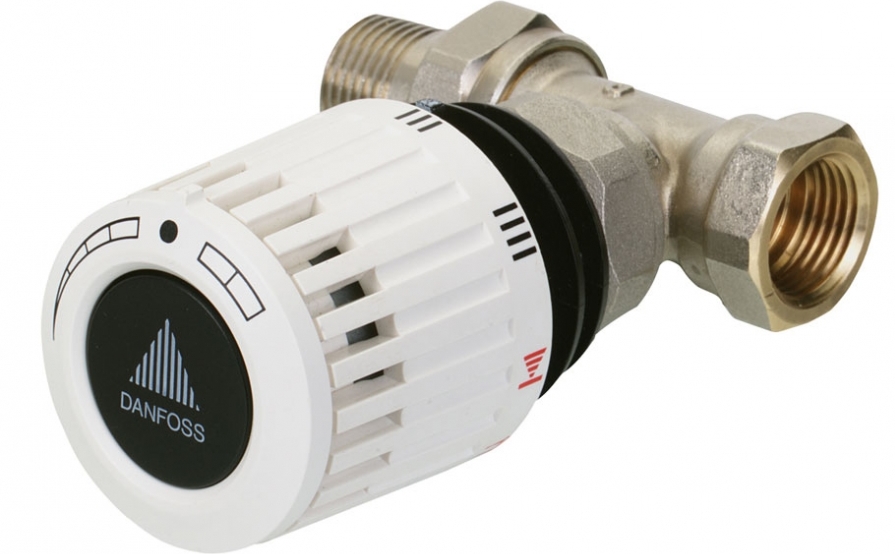
Advantages of the temperature controller:
- Durable, the service life, properly installed, of this product is very large;
- Economical, able to reduce fuel consumption up to 25%;
- Convenient, it is easy to install;
- It supports a certain comfortable temperature regime.
It must be remembered that a reliable thermoregulator must always have a quality certificate. And yet, this device is not suitable for a cast iron radiator.
Installing the thermostat on the radiator: Instruction
For the thermostat to work without problems and effectively, it needs to be installed correctly and accurately, and then set up. This appliance must not be closed to be easily accessible. The installation must be perpendicular to the radiator.
Another nuance of the installation: before it starts, you need to drain the system. But in the non-heating season, the temperature regulators can be completely opened, which will save them from deformation and pollution.
You can install such devices even in apartment house. Installation is carried out by hand in a certain sequence. For this you will need the instruction.
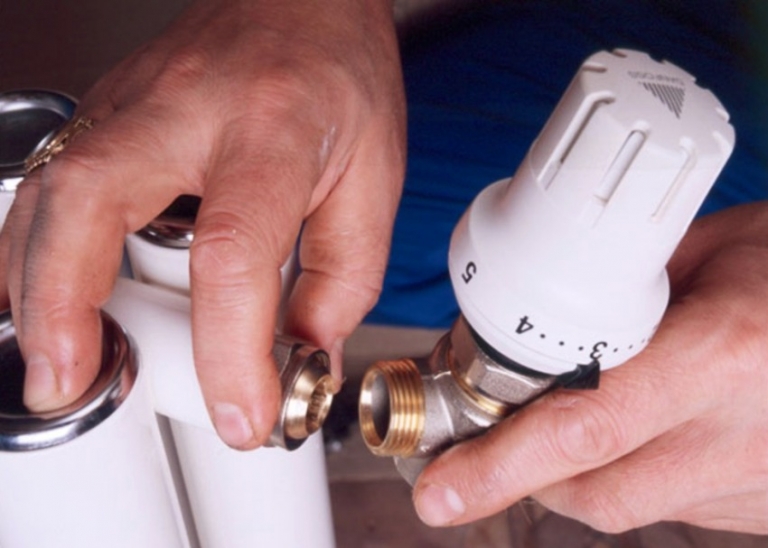
Sequence of work:
- First, you need to cut off the horizontal pipes at a short distance from the battery and disconnect them;
- Remove the crane if it has been installed before this event;
- Now, you need to screw in the battery plugs, a new valve, its nuts and shanks, as well as a thermostatic device;
- Set, in the place chosen by you, the assembled piping harness;
- This harness is then connected to horizontal pipes;
- Afterwards, the radiator with thermostat must be connected to the main riser.
Do not install the thermostat in an upright position, as it will be heated from the battery. From the floor distance should be somewhere 0.8 m. The house, in many floors, it will be easier to equip this equipment if you start from the top, but apartments - from the southern rooms. Usually the regulator is attached to the upper pipe, and the valve is necessarily lower. Disassemble the design of the device will not be very difficult.
Thermoregulator setting: step-by-step actions
In order for the device to work without interruptions, it is very correct and at the same time it maintains a certain temperature, it is necessary to make the necessary adjustments. The heated room must be closed and installed at the right place thermometer, and it will show the correctness of the temperature regime.
Many firms take care of the quality of their products, so they provide special certificates and instructions. The most famous company for the manufacture of temperature controllers is Danfoss. She has the highest quality assurance.
The heat is adjusted manually. If there is heating and temperature adjustment in the radiator - it means that the device works perfectly.
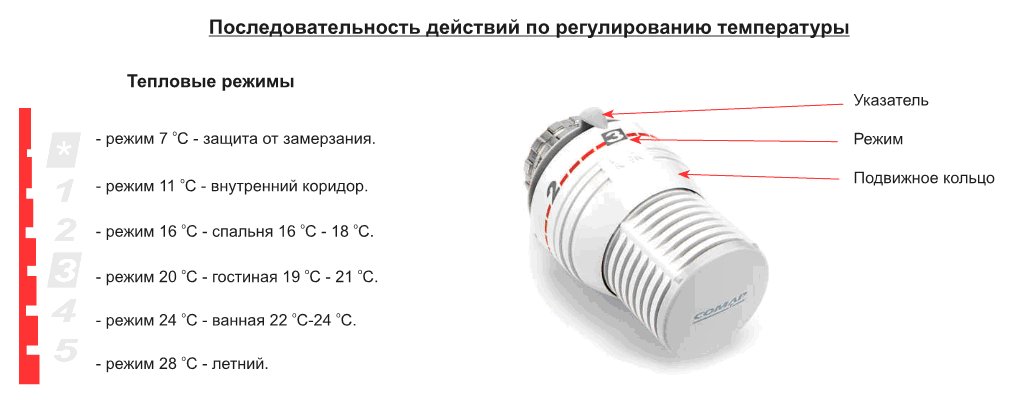
We make the adjustment:
- Close tightly all windows and doors in the room where the check will take place;
- Turn the regulator until the valve is fully open;
- While the radiator is being filled with a coolant, you need to install a thermometer;
- We wait until the air warms up and the thermometer shows a rise in temperature, at least by 6 degrees, then we will have to close the valve;
- When the desired temperature is reached, start slowly opening the tap until noiseless water is heard and the appliance itself does not become warmer. Then you need to stop turning the valve, as the position is selected.
Usually on the cap you can see marked small marks (numbers). They are designed for orientation. Adjusting the device is a very simple task, but thanks to it you can create a cozy and comfortable atmosphere at home.
How to install the thermostat on the battery (video)
Using thermostats together with the heating system, it is able to provide comfortable and comfortable temperature control in a separate room, which becomes an opportunity to save energy resources. Each heating system must have thermostats installed in front of the batteries and perform their technological functions directly. Choose this device can be in the catalog Heizen.
Attention, only TODAY!
Adjust the flow rate of the coolant into the heater (battery or radiator) using a valve that is installed in front of it. This can provide not only comfort, but also provide a certain level of protection in the event of an emergency, in which switching off a part of the pipeline with a radiator is necessary.
For this function, you can consider the possibility of installing such a shut-off valve:
- ball valve;
- conical valve;
- automatic thermostat.
Adjustment with ball valve not very effective, because it is designed only for two modes of operation: open and closed. Intermediate positions of the valve lead to a loss of its tightness, since the solid particles that are contained in the coolant can damage the overlapping ball.
The manual cone valve is much more reliable to regulate the temperature. It can not be completely overlapped. The main thing is not to forget to return it to the initial position. In any case, this type of heating temperature adjustment requires constant attention.
It is most convenient to regulate the temperature in the room with the help of automatic thermostats, which are installed in front of the radiators. They are also called thermostats.
Mechanical thermoregulator design
Each temperature value inside corresponds to a certain value of the pressure of the working medium in the bellows. This pressure is compensated by a spring, which regulates the stroke of the rod.
As the temperature increases, the valve cone moves to the closing position until the pressure of the medium in the bellows is balanced by the force of the spring. If the temperature drops, the process will be reversed.
Advantages of modern thermoregulators
- Modern thermostats have an ergonomic design that fits well with the interior of any room. In addition, they conveniently adjust the temperature;
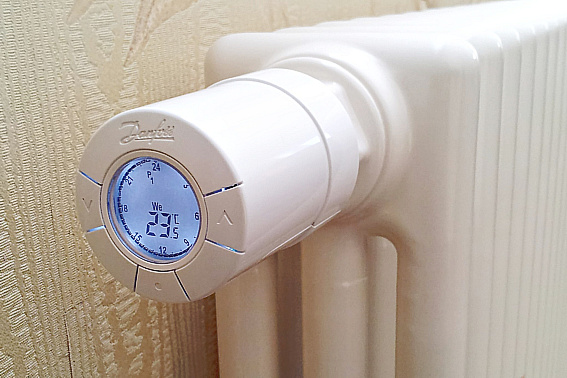
- They are quite easy to install in new and existing heating systems, as this equipment is adapted for local temperature conditions. They can be operated without a preventive and maintenance during the entire service life, which is sufficiently large;
- After the equipment thermostats of radiators of heating there is no need to open windows for temperature regulation in the building;
- The temperature range in which thermostats operate is from 5 ° C to 27 ° C. The temperature can be set at any value in this range and will be maintained to within 1 ° C;
- Thermostats provide an even distribution of the heating medium through the heating system. In this case, even the heating devices that are on the periphery of the circuit will effectively heat the room;
- The thermostat prevents excessive heating of air indoors if direct sunlight gets into the room, or the temperature rises due to other factors (finding people or having electrical appliances);
- When using thermostats in autonomous systemsthey provide fuel savings of up to 25%, which positively affects both the cost of heating and the amount of harmful waste after combustion.
Given the fact that the price of these devices is low, the merits of their use are quite significant:
- saved thermal energy;
- there is an improvement in the microclimate in the premises;
- simplified installation;
- no cost to operate thermostats.
Important! The use of temperature regulators is particularly effective in individual residential projects - private homes and country cottages. In this case, the installation of thermostats pays off within one season.
In conditions central heating Thermostats provide comfortable regulation of the microclimate in the room.
Important! In an apartment, the installation of thermostats must begin from those rooms where the dynamics of temperature change is significant: a kitchen, a living room (where the number of people varies significantly), rooms that receive direct sunlight.
General instructions for installing such equipment are as follows. In private homes, thermostats should first be installed on the upper floors. The reason for this is the following: the heated air rises and the temperature difference in the rooms on the lower floors and on top varies rather.
From the economic point of view it is very effective to install panel radiators with a small capacity with temperature controllers in a private house, which react quickly to the opening and closing of thermostatic valves.
Thermoregulators are subject to certification and quality products must have a certificate of quality or conformity. The market now presents thermostats of two types: gas and liquid. The life of such equipment is about 20 years.
Liquid or gas-filled temperature regulators
Gas-filled thermostats react more quickly to changes in indoor temperature. Liquid temperature controllers respond more accurately and better to the pressure variation inside the corrugated cylinder and transfer it to the actuator more effectively.

Advantages of gas-filled thermostats
The technical solution, in which the thermostat is filled with gas, has several major advantages:
- Condensation of gas passes in the coolest part of the device, the most remote from the valve body. For this reason, the response will be the fastest, since its operation will not depend on the temperature of the water;
- The thermostat of this type reacts well to the dynamics of the room temperature. This allows you to effectively carry out the heat supply.
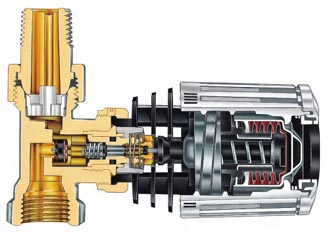
Video with a short overview of temperature controllers:
conclusions
Thermoregulators are especially effective when installed in a individual systems heating, as they, in addition to increasing comfort, have a significant economic effect.
Thermostats can not be installed in all rooms at once, but start from those where the temperature changes most. In this case, the use of thermostats will give the best result.

